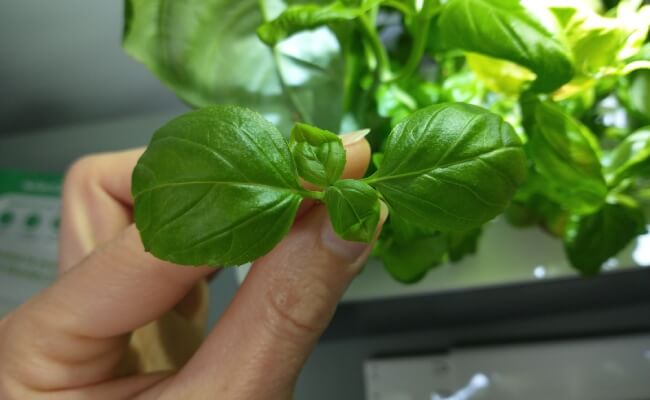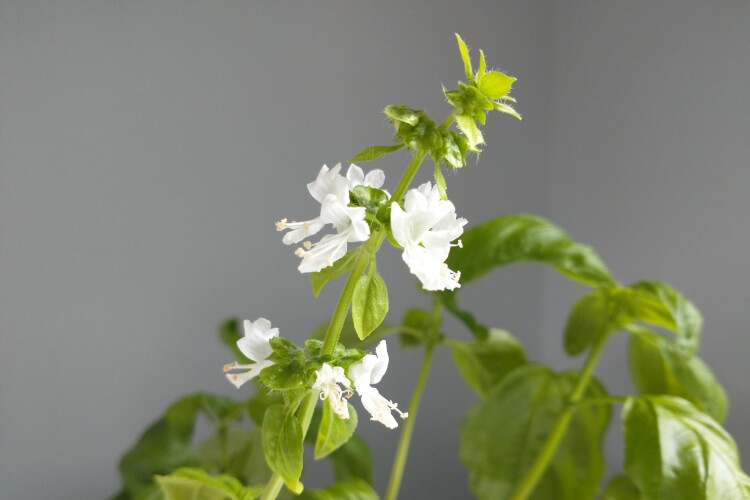Basil is a wonderfully versatile fresh herb that’s popular in home gardens and kitchen windows or countertops. And for good reason- basil is really easy to grow, smells great and tastes great in many recipes and as pesto. But aside from the leaves they’re so well known for, basil can also surprise you by forming a stalk filled with flowers.
Basil flowers are part of the plant’s natural life cycle, eventually producing seeds for next year’s plants. Each flower is small and delicate, and the color varies depending on the type of basil. Besides being pretty, basil flowers are edible and can attract beneficial insects to your garden. But once your plant flowers, the production of flavorful basil leaves slows down or may stop altogether.
In this article, you’ll learn more about what causes basil flowering, what to do with basil flowers that appear and how to keep your plant out of blossom-producing mode.
Let’s get started!
RELATED: Basil comes in several colors, but yellow should not be one of them. Visit our post on how to help a basil plant with yellow leaves to learn more!
Table of Contents
Why Basil Plants Flower
Like most other herb plants, basil plant flowering occurs as part of the natural life cycle of this annual grower. I say annual here, but in some cases the basil blooms can lead to self-seeding and reproduction in the following year, meaning it could come back without any intervention from you.
This of course depends on pollination and where you live, as basil is not frost hardy at all. The basil plant life cycle consists of these three stages:
- Juvenile stage
- Transition stage
- Productive stage
The juvenile stage is marked by lots of leaf growth. During this time, the plant may grow up to 12 inches in a matter of a couple of weeks.
Once the transition stage begins, you’ll see slower leaf growth. This is the time for routine harvesting and pruning; if you don’t keep it pretty aggressively pruned, your plant could reach 4 feet in height.
This is what basil looks like when it’s in the transition stage- there are only leaves emerging from the central stem:

About mid to late summer, basil naturally enters the productive stage, where flowers develop and bloom and the plant markedly slows down new leaf production and growth. You’ll start to see flower spikes or branches with tiny basil leaves and flower buds. These buds open up to flowers and develop seeds if pollinated and left alone.
This is what early flower production looks like:

See how the central stem is producing what looks like a rounded flower bud head instead of just leaves? That’s the beginning of a flower stalk.
Basil flowers will develop if the plants aren’t pruned regularly (or you know- harvested for making pesto and your favorite Italian dishes). Early flowering can also happen if the plant feels that it’s in danger and needs to reproduce right away. A couple of examples include:
- Stress from under-watering
- Prolonged exposure to really hot temperatures (90+ degrees Fahrenheit)
What Do Basil Flowers Look Like?
There are several different cultivars or types of basil plants, most of which will produce basil flowers of different minor variations.
According to Clemson Cooperative Extension, some basil cultivars do not produce any flower spikes, but most will sprout dainty purple or white basil blooms. These blooms usually occur in spikes or small clusters in different shapes depending on the cultivar.
The bright-green sweet basil Italiano Classico (the one you most often see in nurseries and home improvement stores) produces white flowers. Here are some lovely flowers on my basil:

Red Rubin and Purple Petra varieties yield purple flowers:

Italian Genovese basil grows white flowers, very similar to that of sweet basil:

Thai basil has purple stems that produce purple flowers:

Learn how to grow thai basil in our comprehensive guide!
These flowers are really quite beautiful and fragrant! In any of its many varieties, basil is a great addition to the garden.
What Can You Do with Basil Flowers?
So these little blossoms are certainly pretty, but are basil flowers edible? Yes! The University of Minnesota Extension states that fresh basil flowers typically taste like mild basil, while some varieties may taste differently or like the cultivar of basil they grow from.
Here are some great everyday uses for basil flowers:
• Salad: Top a salad with basil flowers for added flavor and a pretty look.
• Infused vinegar: Fill a jar with the fresh basil flowers and cover with red or white vinegar. Place in a dark cabinet for 2 weeks, then strain out the flowers for basil flower-infused vinegar.
• Infused olive oil: Wash and dry basil flowers thoroughly. Fill a jar with the dried basil flowers and cover with olive oil. Place in a dark cabinet for 4-6 weeks, strain out the flowers, and you’ve got basil-infused olive oil for cooking, marinating or salad dressing.
• Tomato sauce: Basil flowers give homemade tomato sauce a subtle basil flavor rather than basil leaves, or add the flowers to any canned or jarred sauce to add fresh basil flavor.
• Pesto: Replace the basil leaves in your favorite pesto recipe with basil blooms. Makes a great marinade and topping for beef, chicken, or fish, a delicious addition for any pasta dish or a savory bruschetta topping.
• Tea: Steep some basil flowers in boiling water for a few minutes for a tasty tea. Let it cool and you’ll have some refreshing drinking water for a hot day working in your garden.
• Decoration: Place basil flowers in a bud vase in your kitchen window for color and fragrance.
• Garnish: Put some basil flowers on a charcuterie board with cheese and crackers or on a pasta dish for presentation.
Pick your basil flowers when they’re young and before all of them bloom, when they tend to be the most tender and easy to eat.
RELATED: Broccoli is another garden plant that will go to flower if you let it. Should you let it? Find out what’s going on when broccoli starts to blossom.
What Happens If You Let Basil Flower?
So you’ve harvested your weight in basil throughout the summer. Or the growing season is coming to an end, and you’re unsure what to do with your basil plants. What happens when you stop pruning your basil and pinching off basil blooms?
- The blossoms are edible, and as you’ve seen in the previous section, you can make several different recipes and teas with basil blooms.
- You can leave the basil blooms to attract bees and other beneficial insects to your garden.
- Leave the basil blooms in place for some pretty color and lovely fragrance through the end of the growing season.
- You could collect seeds from your basil flowers. After pollination, cut off the spent flower heads and dry them for several days on a warm, sunny windowsill. Then crush the dried flower heads over a fine colander. Store in an air-tight container in a dark place, and they will be good for several years. This video from MIGardener demonstrates this technique well:
- In USDA hardiness zones 11-13, basil is a perennial and may self-seed from pollinated flowers. If that happens, you’ll see new basil plants return the following season.
How to Remove Basil Flowers
If you’re not done harvesting basil leaves for the season and you find your basil plant flowering, remove the flowers to encourage more (and bushier) leaf growth.
All it takes is a little pinch between your thumb and index finger. This is done at the base of the basil flower bunch and above the closest leaf set to remove the flower spike, but you can also snip them off with a pair of clean scissors. It’s that easy-and your basil plant will thank you by growing even fuller!
This is what your plant looks like when it’s just starting to form a flower stalk:

Pinch off the flower buds as soon as you notice them, before the blooms open. This redirects the basil plant’s energy to growing more stems and leaves rather than flowers and seeds.
Now you smell a little like an Italian kitchen!
How to Keep Basil From Flowering
Even though flowering is a natural part of basil’s life cycle, slowing the flowering process down gets you the longest basil leaf harvest possible.
The very best way to prevent basil plant flowering is to pinch off the blooms when they start and before opening. Harvest or prune your basil at least once every couple of weeks, and this will actually help it grow back even bushier than before. Pruning sends the message that it needs to produce more stems and leaves rather than flowers, so trim frequently.
Brody Hall, certified horticulturist and co-founder of The Indoor Nursery, shares that light exposure also has a significant effect on flower production. “The flowering of basil is regulated by the plant’s photoperiod, or the length of time it is exposed to light each day. Longer photoperiods (more exposure to light each day) promote flowering, while shorter photoperiods (less exposure to light each day) suppress flowering.”
If you’ve got your basil in your kitchen and you’re using a grow light, Brody recommends keeping the grow light off for at least 12 hours every day.
You don’t have as much control over how many hours of sunlight your basil in the outdoor garden, so you’ll have to rely more heavily on frequent harvesting and pruning.
And, of course, be sure your basil plant is getting enough water. Drought conditions or lack of watering can make it switch to the flowering mode or production stage.
In some cases, you just can’t stop basil plants from blooming despite your best efforts. But that’s wonderful for the bee population in your area, and you can enjoy the lovely blossoms, too.

Frequently Asked Questions about Basil Flowers
Final Thoughts
As much as basil leaves are a versatile and tasty addition to your garden, basil flowers have a lot to offer too, especially at the end of the growing season. They’re beautiful, tasty, fragrant, and an attractor for bees and other beneficial insects.
But if you’d like to hold off on the blooming until the very end, there’s nothing wrong with that either. Just keep that basil plant well-trimmed and enjoy the fresh leaves with abandon. You really can’t go wrong either way!
We want to hear your thoughts! Are there any other questions about basil that we didn’t answer? Do you have any other ways you like to use the blossoms? We learn best from one another, so please share your thoughts in the comments!

